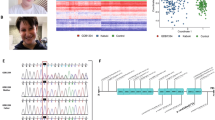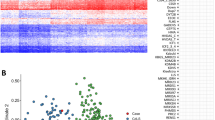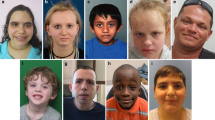Abstract
The importance of epigenetic control in the development of the central nervous system has recently been attracting attention. Methylation patterns of lysine 4 and lysine 36 in histone H3 (H3K4 and H3K36) in the central nervous system are highly conserved among species. Numerous complications of body malformations and neuropsychiatric disorders are due to abnormal histone H3 methylation modifiers. In this study, we analyzed a Japanese family with a dominant inheritance of symptoms including Marfan syndrome-like minor physical anomalies (MPAs), intellectual disability, and schizophrenia (SCZ). We performed positional cloning for this family using a single nucleotide polymorphism (SNP) array and whole-exome sequencing, which revealed a missense coding strand mutation (rs1555289644, NM_032590.4: c.2173G>A, p.A725T) in exon 15 on the plant homeodomain of the KDM2B gene as a possible cause of the disease in the family. The exome sequencing revealed that within the coding region, only a point mutation in KDM2B was present in the region with the highest logarithm of odds score of 2.41 resulting from whole genome linkage analysis. Haplotype analysis revealed co-segregation with four affected family members (IV-9, III-4, IV-5, and IV-8). Lymphoblastoid cell lines from the proband with this mutation showed approximately halved KDM2B expression in comparison with healthy controls. KDM2B acts as an H3K4 and H3K36 histone demethylase. Our findings suggest that haploinsufficiency of KDM2B in the process of development, like other H3K4 and H3K36 methylation modifiers, may have caused MPAs, intellectual disability, and SCZ in this Japanese family.
This is a preview of subscription content, access via your institution
Access options
Subscribe to this journal
Receive 12 print issues and online access
$259.00 per year
only $21.58 per issue
Buy this article
- Purchase on Springer Link
- Instant access to full article PDF
Prices may be subject to local taxes which are calculated during checkout




Similar content being viewed by others
References
Dincer A, Gavin DP, Xu K, Zhang B, Dudley JT, Schadt EE, et al. Deciphering H3K4me3 broad domains associated with gene-regulatory networks and conserved epigenomic landscapes in the human brain. Transl Psychiatry. 2015;5:e679–e679.
Collins BE, Greer CB, Coleman BC, Sweatt JD. Histone H3 lysine K4 methylation and its role in learning and memory. Epigenetics Chromatin. 2019;12:7.
Zaghi M, Broccoli V, Sessa A. H3K36 methylation in neural development and associated diseases. Front Genet. 2020;10:1–9.
Faundes V, Newman WG, Bernardini L, Canham N, Clayton-Smith J, Dallapiccola B, et al. Histone lysine methylases and demethylases in the landscape of human developmental disorders. Am J Hum Genet. 2018;102:175–87.
Huang HS, Matevossian A, Whittle C, Se YK, Schumacher A, Baker SP, et al. Prefrontal dysfunction in schizophrenia involves mixed-lineage leukemia 1-regulated histone methylation at GABAergic gene promoters. J Neurosci. 2007;27:11254–62.
Shulha HP, Cheung I, Whittle C, Wang J, Virgil D, Lin CL, et al. Epigenetic signatures of autism: Trimethylated H3K4 landscapes in prefrontal neurons. Arch Gen Psychiatry. 2012;69:314–24.
Iossifov I, O’Roak BJ, Sanders SJ, Ronemus M, Krumm N, Levy D, et al. The contribution of de novo coding mutations to autism spectrum disorder. Nature 2014;515:216–21.
Lumish HS, Wynn J, Devinsky O, Chung WK. Brief Report: SETD2 mutation in a child with autism, intellectual disabilities and epilepsy. J Autism Dev Disord. 2015;45:3764–70.
Abecasis GR, Cherny SS, Cookson WO, Cardon LR. Merlin — rapid analysis of dense genetic maps using sparse gene flow trees. Nat Genet. 2002;30:97–101.
Wigginton JE, Abecasis GR. PEDSTATS: descriptive statistics, graphics and quality assessment for gene mapping data. Bioinformatics 2005;21:3445–7.
Lander E, Kruglyak L. Genetic dissection of complex traits: guidelines for interpreting and reporting linkage results. Nat Genet. 1995;11:241–7.
Kasamo K, Nakamura M, Daimou Y, Sano A. A PRIMPOL mutation and variants in multiple genes may contribute to phenotypes in a familial case with chronic progressive external ophthalmoplegia symptoms. Neurosci Res. 2020;157:58–63.
Hiromi U, Masayuki N, Mio N, Kato Y, Shu-ichi U, Akira S. Positional cloning and comprehensive mutation analysis of a Japanese family with lithium-responsive bipolar disorder identifies a novel DOCK5 mutation. J Hum Genet. In press.
Tadaka S, Saigusa D, Motoike IN, Inoue J, Aoki Y, Shirota M, et al. jMorp: Japanese multi omics reference panel. Nucleic Acids Res. 2018;46(Jan):D551–7.
Loeys BL, Dietz HC, Braverman AC, Callewaert BL, De Backer J, Devereux RB, et al. The revised Ghent nosology for the Marfan syndrome. J Med Genet. 2010;47:476–85.
Tsukada Y-I, Fang J, Erdjument-Bromage H, Warren ME, Borchers CH, Tempst P, et al. Histone demethylation by a family of JmjC domain-containing proteins. Nature. 2006;439:811–6.
Yan M, Yang X, Wang H, Shao Q. The critical role of histone lysine demethylase KDM2B in cancer. Am J Transl Res. 2018;10:2222–33.
Fukuda T, Tokunaga A, Sakamoto R, Yoshida N. Molecular and cellular neuroscience Fbxl10 / Kdm2b de fi ciency accelerates neural progenitor cell death and leads to exencephaly. Mol Cell Neurosci. 2011;46:614–24.
Peña PV, Davrazou F, Shi X, Walter KL, Verkhusha VV, Gozani O, et al. Molecular mechanism of histone H3K4me3 recognition by plant homeodomain of ING2. Nature. 2006;442:100–3.
Li H, Ilin S, Wang W, Duncan EM, Wysocka J, Allis CD, et al. Molecular basis for site-specific read-out of histone H3K4me3 by the BPTF PHD finger of NURF. Nature. 2006;442:91–5.
Petrovski S, Wang Q, Heinzen EL, Allen AS, Goldstein DB. Genic intolerance to functional variation and the interpretation of personal genomes. PLoS Genet. 2013;9:e1003709.
Girard SL, Gauthier J, Noreau A, Xiong L, Zhou S, Jouan L, et al. Increased exonic de novo mutation rate in individuals with schizophrenia. Nat Genet. 2011;43:860–3.
Labonne JDJ, Han K, Shigeki L, Il I, Kong K, Diamond MP, et al. An atypical 12q24. 31 microdeletion implicates six genes including a histone demethylase KDM2B and a histone methyltransferase SETD1B in syndromic intellectual disability. Hum Genet. 2016;135:757–71.
Charng W-L, Karaca E, Coban Akdemir Z, Gambin T, Atik MM, Gu S, et al. Exome sequencing in mostly consanguineous Arab families with neurologic disease provides a high potential molecular diagnosis rate. BMC Med Genomics. 2016;9:42.
Salminen A, Kaarniranta K, Kauppinen A. Hypoxia-inducible histone lysine demethylases: impact on the aging process and age-related diseases. Aging Dis. 2016;7:180–200.
Long HK, Blackledge NP, Klose RJ. ZF-CxxC domain-containing proteins, CpG islands and the chromatin connection. Biochem Soc Trans. 2013;41:727–40.
Blackledge NP, Farcas AM, Kondo T, King HW, McGouran JF, Hanssen LLP, et al. Variant PRC1 complex-dependent H2A ubiquitylation drives PRC2 recruitment and polycomb domain formation. Cell. 2014;157:1445–59.
Vashishtha M, Ng CW, Yildirim F, Gipson TA, Kratter IH, Bodai L, et al. Targeting H3K4 trimethylation in Huntington disease. Proc Natl Acad Sci. 2013;110:E3027–36.
Rayasam GV, Wendling O, Angrand PO, Mark M, Niederreither K, Song L, et al. NSD1 is essential for early post-implantation development and has a catalytically active SET domain. EMBO J. 2003;22:3153–63.
Cascante A, Klum S, Biswas M, Antolin-fontes B, Barnabé-heider F, Hermanson O. Gene-specific methylation control of H3K9 and H3K36 on neurotrophic BDNF versus astroglial GFAP genes by KDM4A/ C regulates neural stem cell differentiation. J Mol Biol. 2014;426:3467–77.
Koemans TS, Kleefstra T, Chubak MC, Stone MH, Reijnders MRF, de Munnik S, et al. Functional convergence of histone methyltransferases EHMT1 and KMT2C involved in intellectual disability and autism spectrum disorder. PLOS Genet. 2017;13:e1006864.
Tunovic S, Barkovich J, Sherr EH, Slavotinek AM. De novo ANKRD11 and KDM1A gene mutations in a male with features of KBG syndrome and Kabuki syndrome. Am J Med Genet Part A. 2014;164:1744–9.
Ng SB, Bigham AW, Buckingham KJ, Hannibal MC, McMillin MJ, Gildersleeve HI, et al. Exome sequencing identifies MLL2 mutations as a cause of Kabuki syndrome. Nat Genet. 2010;42:790–3.
Singh T, Kurki MI, Curtis D, Purcell SM, Crooks L, McRae J, et al. Rare loss-of-function variants in SETD1A are associated with schizophrenia and developmental disorders. Nat Neurosci. 2016;19:571–7.
Nimura K, Ura K, Shiratori H, Ikawa M, Okabe M, Schwartz RJ, et al. LETTERS A histone H3 lysine 36 trimethyltransferase links Nkx2-5 to Wolf – Hirschhorn syndrome. Nature 2009;460:287–91.
Miyake N, Koshimizu E, Okamoto N, Mizuno S, Ogata T, Nagai T, et al. MLL2 and KDM6A mutations in patients with Kabuki syndrome. Am J Med Genet Part A. 2013;161:2234–43.
Iwase S, Lan F, Bayliss P, de la Torre-Ubieta L, Huarte M, Qi HH, et al. The X-linked mental retardation gene SMCX/JARID1C defines a family of histone H3 lysine 4 demethylases. Cell 2007;128:1077–88.
Abidi FE, Holloway L, Moore CA, Weaver DD, Simensen RJ, Stevenson RE, et al. Mutations in JARID1C are associated with X-linked mental retardation, short stature and hyperreflexia. J Med Genet. 2008;45:787–93.
Chong JX, Yu JH, Lorentzen P, Park KM, Jamal SM, Tabor HK, et al. Gene discovery for Mendelian conditions via social networking: De novo variants in KDM1A cause developmental delay and distinctive facial features. Genet Med. 2016;18:788–95.
Huang N, Lee I, Marcotte EM, Hurles ME. Characterising and predicting haploinsufficiency in the human genome. PLoS Genet. 2010;6:e1001154.
Acknowledgements
The authors thank all involved patients and their families for their participation. The authors thank Ms. Hiwatashi, Ms. Meguro, Ms. Nishimura, Ms. Shimomura and Ms. Yokoyama for their technical assistance. We thank Dr. Kasamo and Dr. Urata for their technical advisees. We also thank Dr. Ishida for editing this manuscript. We would like to thank Uni-edit (https://uni-edit.net/) for editing and proofreading this manuscript. This work was supported by MEXT KAKENHI Grant Number JP15K09811.
Author information
Authors and Affiliations
Corresponding author
Ethics declarations
Conflict of interest
The authors declare that they have no conflict of interest.
Additional information
Publisher’s note Springer Nature remains neutral with regard to jurisdictional claims in published maps and institutional affiliations.
Supplementary information
Rights and permissions
About this article
Cite this article
Yokotsuka-Ishida, S., Nakamura, M., Tomiyasu, Y. et al. Positional cloning and comprehensive mutation analysis identified a novel KDM2B mutation in a Japanese family with minor malformations, intellectual disability, and schizophrenia. J Hum Genet 66, 597–606 (2021). https://doi.org/10.1038/s10038-020-00889-4
Received:
Revised:
Accepted:
Published:
Issue Date:
DOI: https://doi.org/10.1038/s10038-020-00889-4
This article is cited by
-
KDM2B regulates hippocampal morphogenesis by transcriptionally silencing Wnt signaling in neural progenitors
Nature Communications (2023)
-
ATAD3B and SKIL polymorphisms associated with antipsychotic-induced QTc interval change in patients with schizophrenia: a genome-wide association study
Translational Psychiatry (2022)



